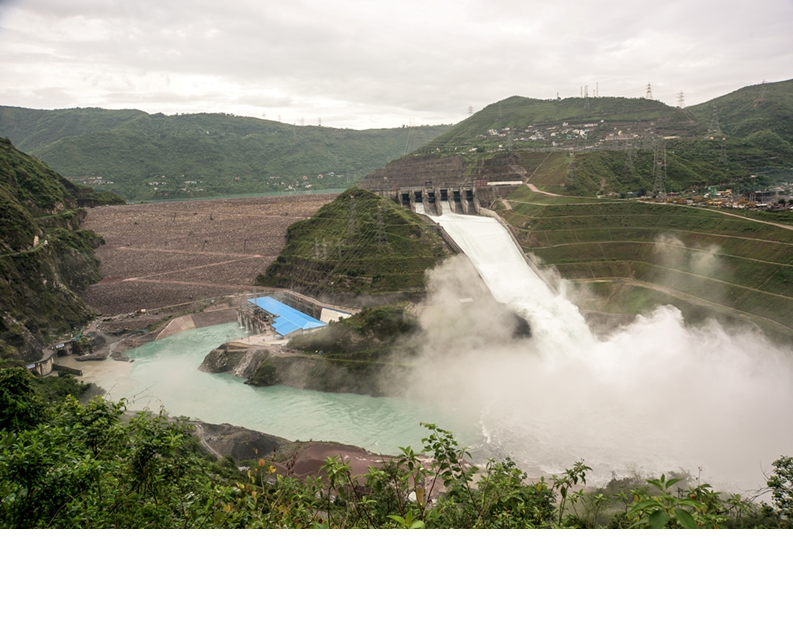Koldam Dam on:
[Wikipedia]
[Google]
[Amazon]
 The Koldam Hydropower Station commonly known as Koldam, is an
The Koldam Hydropower Station commonly known as Koldam, is an 
 The Koldam Hydropower Station commonly known as Koldam, is an
The Koldam Hydropower Station commonly known as Koldam, is an embankment dam
An embankment dam is a large artificial dam. It is typically created by the placement and compaction of a complex semi-plastic mound of various compositions of soil or rock. It has a semi-pervious waterproof natural covering for its surface and ...
on the Sutlej River
The Sutlej or Satluj River () is the longest of the five rivers that flow through the historic crossroads region of Punjab in northern India and Pakistan. The Sutlej River is also known as ''Satadru''. It is the easternmost tributary of the Ind ...
upstream of the Dehar Power House
The Pandoh Dam is an embankment dam on the Beas River in Mandi district of Himachal Pradesh, India. Under the Beas Project, the dam was completed in 1977 and its primary purpose is hydroelectric power generation. Part of a run-of-the-river power ...
. It is 18 km from Bilaspur off the Chandigarh-Manali Highway (NH-21) near Barmana, Himachal Pradesh
Himachal Pradesh (; ; "Snow-laden Mountain Province") is a state in the northern part of India. Situated in the Western Himalayas, it is one of the thirteen mountain states and is characterized by an extreme landscape featuring several peaks ...
, India. The main purpose of the dam is hydroelectric
Hydroelectricity, or hydroelectric power, is electricity generated from hydropower (water power). Hydropower supplies one sixth of the world's electricity, almost 4500 TWh in 2020, which is more than all other renewable sources combined and ...
power generation and it will support an 800 MW power station. The dam was constructed by NTPC Limited (erstwhile National Thermal Power Corporation Limited).
Koldam project was first conceived in mid‐sixties and investigations on various possible sites had been in progress since 1966. Based on investigation carried out until 1975, a project report was prepared which envisaged construction of rockfill dam having an installed capacity of 600 MW. The work of investigation and studies was taken by HPSEB in October, 1984. The project capacity was revised to 800 MW, but work did not start for lack of funds. Subsequently, Koldam Hydro Project was taken over by NTPC in 2000 and Project Report was revised with a 167m high rock fill dam and Surface Power House located at toe of the dam with installed capacity of 4X200 MW.
The foundation stone for the dam was laid on 5 June 2000 by Prime Minister Atal Bihari Vajpayee
Atal Bihari Vajpayee (; 25 December 1924 – 16 August 2018) was an Indian politician who served three terms as the 10th prime minister of India, first for a term of 13 days in 1996, then for a period of 13 months fr ...
. On 14 January 2004, main construction on the dam began. KB Dubey was the first Head of the Project (BUH) . The current BUH is NS Thakur (since 2020).
Due to problems associated with geological issues and declaration of part of reservoir area in 2006 as extension of Majathal Wildlife Sanctuary, the project got delayed. Attempts to impound the reservoir first failed in December 2013 due to problems with sealing the diversion tunnels. By 18 March 2014, a fourth attempt to seal the tunnels and fill the lake was underway. Repairs were made and another unsuccessful impounding was reached in April 2014 as the diversion tunnel continued to leak. Another period of impounding began on 3 November 2014 and finished on 3 January 2015. A tunnel still leaked though but authorities were confident they would have the power station operational by April. Generator commissioning was originally scheduled for 2009 but was rescheduled to 2015.

Construction
The contract of construction of dam was awarded to Thailand's ITD Public Company Limited. A joint venture company of BHEL, Toshiba and Marubeni supplied turbines and generators.Power Generation Capacity
Its installed capacity is of 800 MW (4x200 MW). The first 200 MWFrancis turbine
The Francis turbine is a type of water turbine. It is an inward-flow reaction turbine that combines radial and axial flow concepts. Francis turbines are the most common water turbine in use today, and can achieve over 95% efficiency.
The proces ...
-generator was commissioned on 30 March 2015 and the third on 10 April 2015.
See also
* Bhakra Dam – located downstream *Pandoh Dam
The Pandoh Dam is an embankment dam on the Beas River in Mandi district of Himachal Pradesh, India. Under the Beas Project, the dam was completed in 1977 and its primary purpose is hydroelectric power generation. Part of a run-of-the-river power ...
References
{{Power Projects in Himachal Pradesh Dams in Himachal Pradesh Hydroelectric power stations in Himachal Pradesh Rock-filled dams Dams on the Sutlej River Dams completed in 2015 Energy infrastructure completed in 2015 2015 establishments in Himachal Pradesh Buildings and structures in Mandi district